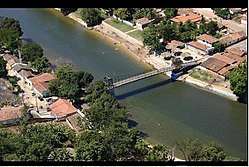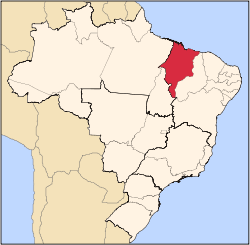Balsas, Maranhão
Balsas (Portuguese pronunciation: [ˈbawsɐs ]) is a city in the state of Maranhão, northeast Brazil. It is located in southern Maranhão, 800 km from the capital of the state, São Luís.
- For the Mexican river, see Balsas River. For the Ecuadorian canton, see Balsas, Ecuador.
Balsas | |
|---|---|
Municipality | |
| The Municipality of Balsas | |
 Flag  Seal | |
| Nicknames: "Bls", "Balsinhas de Açúcar", "Princesinha do Sul do Maranhão", "Capital da Agricultura e da Lavoura Mecanizada" ("Bls", "Little Sugar Ferries", "Little Princess of Southern Maranhão", "Capital of the Mechanized Agriculture") | |
 Location of Balsas in the State of Maranhão | |
| Coordinates: 07°31′38″S 46°02′39″W | |
| Country | Brazil |
| Region | Northeast |
| State | Maranhão |
| Founded | March 22, 1918 |
| Government | |
| • Mayor | Erik Augusto Costa e SilvaPDT) |
| Area | |
| • Total | 13,141.637 km2 (5,074.014 sq mi) |
| [1] | |
| Elevation | 283 m (928 ft) |
| Population (2012) | |
| • Total | 87,057 |
| • Density | 6.6/km2 (17/sq mi) |
| [2] | |
| Time zone | UTC-3 (UTC-3) |
| HDI (2000) | 0.696 – medium[3] |
| Website | www.balsas.ma.gov.br |
Geography
Balsas covers an area of 13,141.64 km², being the largest municipality in Maranhão. The median elevation of the city is 283 meters (810 ft).
Climate
Balsas has a Savanna tropical climate. Temperature is hot from April through October. It rains from November through March.
Vegetation
Cerrado is the typical vegetation of the area. However, due to the advance of agricultural activities, the ecosystems is threatened.
Hydrography

There are many streams and rivers in the municipality, but the most important is Rio Balsas, which crosses the city.
Demographics
According to 2001 census, Balsas has 60,613 inhabitants. 82.73% live in Urban areas. The infant mortality rate is 35.1 deaths /1,000 live births and life expectancy is 64.1 years.
The annual median growth of the population is 4.21%. In 2007 the population was over 78,000 inhabitants. The city is the seat of the Roman Catholic Diocese of Balsas.
References
- IBGE - "Archived copy". Archived from the original on January 9, 2007. Retrieved August 3, 2014.CS1 maint: archived copy as title (link)
- "2012 Populational Estimate" (PDF). Censo Populacional 2012. Instituto Brasileiro de Geografia e Estatística (IBGE). July 2012. Retrieved August 31, 2012.
- "Archived copy". Archived from the original on 2009-10-03. Retrieved 2009-12-17.CS1 maint: archived copy as title (link) UNDP
